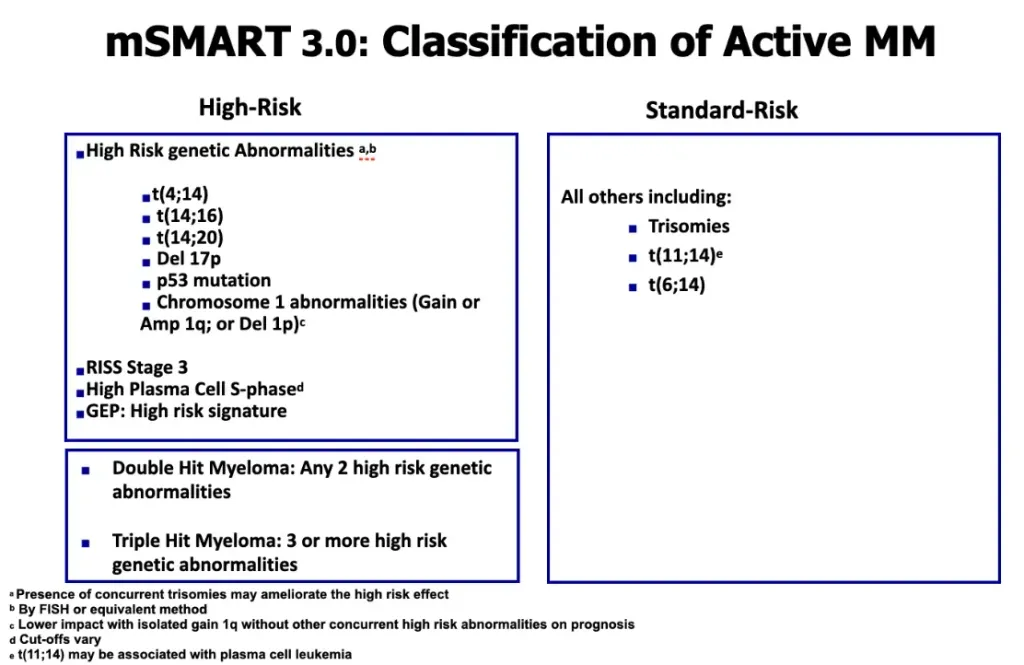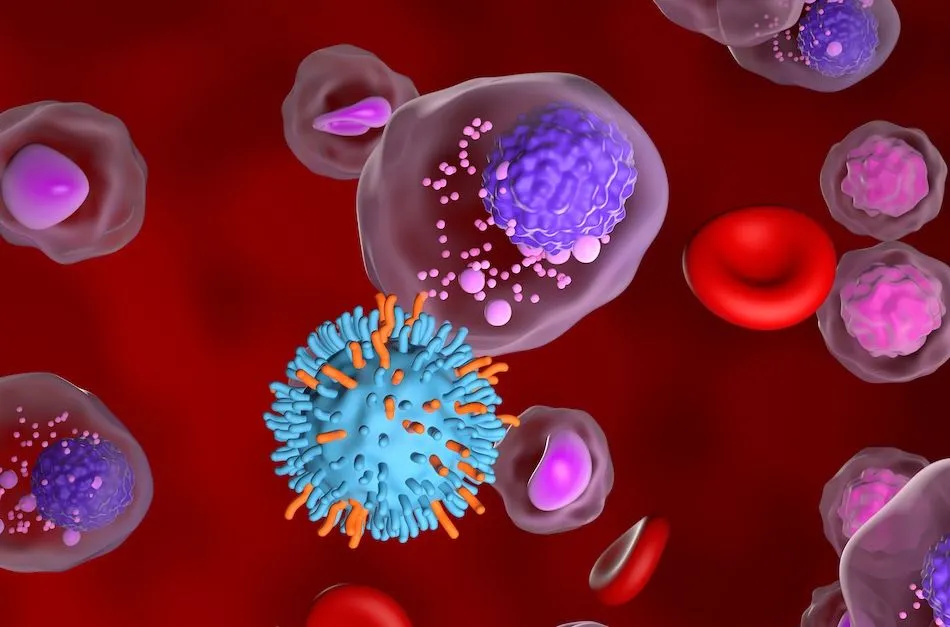What’s Genetic Testing in Multiple Myeloma?

We recently had the privilege of having Dr. Attaya Suvannasankha speak to the HealthTree Newly Diagnosed Myeloma Group on January 18th, 2024.
Dr. Suvannasankha presented a comprehensive guide on assessing risk in multiple myeloma, the most common genetic mutations, and their importance for multiple myeloma patients.
Understanding the Origin of Myeloma and the Need for Genetic Testing
Below is a summary of what Dr. Suvannasankha presented to newly diagnosed myeloma patients.
Multiple myeloma is a complex genetic blood cancer that affects plasma cells, immune cells that produce antibodies. Understanding its genetic abnormalities is important for precise diagnosis and treatment.
To comprehend the genetic changes of myeloma cells, it’s important to identify the two types of mutations that can present in cells:
- Germline mutations are generated in eggs or sperm cells only. They are present at birth and can be passed down to offspring (inherited).
- Somatic mutations occur in other tissue cells and cannot be inherited. The mutations present in multiple myeloma are somatic.
Genetic alterations arise in the early stages of multiple myeloma and continue to develop throughout its progression. Understanding how these mutations work in the cells is important because mutations that affect myeloma usually interfere with the myeloma cell’s life cycle. Mutations can also “camouflage” cancer cells from immune cells in charge of eliminating cancer cells.
Determining A Myeloma Patient’s Risk Based On Their Genetics
Multiple myeloma patients are classified as standard, intermediate, and high-risk. Those who have high-risk myeloma are less likely to respond to treatment or relapse after completing a line of treatment.
The mSMART classification for active myeloma patients helps determine the patient's risk. Understanding a patient’s risk and how to classify it helps personalize a treatment that will effectively control the myeloma.
Understanding the genetics and prognosis linked to them can also predict myeloma survival.
Those with specific genetic characteristics found in bone marrow genetic tests such as t(4;14), t(14;16), and deletion 17p are considered high-risk patients. Genetic translocations such as t(11;14) are considered standard risk. The table above helps doctors classify the risk of myeloma patients based on their genetics. But, it’s helpful for patients to understand their risk to talk to their physician about their best treatment options that are risk-specific.
Genetic analysis of myeloma has led to the discovery of therapies that work best in the most common mutations, resulting in better patient responses.
What Are The Genetic Tests for Multiple Myeloma?
Once one understands the importance of genetic testing in multiple myeloma, it’s relevant to know how these tests are performed and why they are done that way. When a doctor detects a myeloma patient, one of the first things to find out is the genetics.
All of these tests are performed in the bone marrow plasma cells obtained from a bone marrow biopsy.
- FISH (fluorescent in situ hybridization): utilizes fluorescent dyes to map out genetic material, identifying chromosome changes such as deletions or translocations.
- Karyotype: lines up all the chromosomes to identify abnormalities in chromosome number or structure.
- Genomics (DNA sequencing), gene expression profiling, next-generation sequencing, polymerase chain reaction, etc.
What if you have high-risk multiple myeloma?
Receiving a high-risk myeloma diagnosis means needing closer monitoring of the myeloma status, even after receiving treatment, because it has a higher risk of relapsing or not responding as expected to the standard treatment lines.
A high-risk diagnosis also helps doctors determine a strategy to control myeloma effectively and allows researchers to monitor patients and prevent relapse by developing new medication and therapy combinations for risk-specific myeloma.
Audience Q&A
During the event, Dr. Suvannasankha answered several patient questions. Some of these included:
- 42:22 Is one born with the potential for developing myeloma?
- 46:01 Is the myeloma immunophenotype the same as genetics or genomics?
- 48:41 How can FISH results change during the course of the disease, and how often is it recommended that myeloma patients repeat FISH tests to detect any new abnormalities or changes?
- 51:50 How does functional high-risk differ from high-risk myeloma?
- 52:26 How concerning is it to this date to be considered high-risk?
- 57:45 What is the difference between 1q gain and 1q amplification, and are there any specific treatments for this group of patients?
- 60:01 What does the percentage in flow cytometry or FISH results mean?
Unlock Personal Insights Into Your Diagnosis for Free with HealthTree Cure Hub, the platform that powers life-saving research!
Your genetic results can be added to your HealthTree Cure Hub Profile, which will help myeloma patients find patterns of treatments and outcomes based on myeloma genetics. Create a HealthTree profile, and if you need help reading the test results, you can upload your printout, and we can help enter the information for you.
By securely connecting your electronic health records, HealthTree Cure Hub allows you to discover treatment options, find a specialist, keep track of your disease, and so much more! Sign up for a free patient account today to get started.
Want to Know More About Genetics in Myeloma?
We recently had the privilege of having Dr. Attaya Suvannasankha speak to the HealthTree Newly Diagnosed Myeloma Group on January 18th, 2024.
Dr. Suvannasankha presented a comprehensive guide on assessing risk in multiple myeloma, the most common genetic mutations, and their importance for multiple myeloma patients.
Understanding the Origin of Myeloma and the Need for Genetic Testing
Below is a summary of what Dr. Suvannasankha presented to newly diagnosed myeloma patients.
Multiple myeloma is a complex genetic blood cancer that affects plasma cells, immune cells that produce antibodies. Understanding its genetic abnormalities is important for precise diagnosis and treatment.
To comprehend the genetic changes of myeloma cells, it’s important to identify the two types of mutations that can present in cells:
- Germline mutations are generated in eggs or sperm cells only. They are present at birth and can be passed down to offspring (inherited).
- Somatic mutations occur in other tissue cells and cannot be inherited. The mutations present in multiple myeloma are somatic.
Genetic alterations arise in the early stages of multiple myeloma and continue to develop throughout its progression. Understanding how these mutations work in the cells is important because mutations that affect myeloma usually interfere with the myeloma cell’s life cycle. Mutations can also “camouflage” cancer cells from immune cells in charge of eliminating cancer cells.
Determining A Myeloma Patient’s Risk Based On Their Genetics
Multiple myeloma patients are classified as standard, intermediate, and high-risk. Those who have high-risk myeloma are less likely to respond to treatment or relapse after completing a line of treatment.
The mSMART classification for active myeloma patients helps determine the patient's risk. Understanding a patient’s risk and how to classify it helps personalize a treatment that will effectively control the myeloma.
Understanding the genetics and prognosis linked to them can also predict myeloma survival.
Those with specific genetic characteristics found in bone marrow genetic tests such as t(4;14), t(14;16), and deletion 17p are considered high-risk patients. Genetic translocations such as t(11;14) are considered standard risk. The table above helps doctors classify the risk of myeloma patients based on their genetics. But, it’s helpful for patients to understand their risk to talk to their physician about their best treatment options that are risk-specific.
Genetic analysis of myeloma has led to the discovery of therapies that work best in the most common mutations, resulting in better patient responses.
What Are The Genetic Tests for Multiple Myeloma?
Once one understands the importance of genetic testing in multiple myeloma, it’s relevant to know how these tests are performed and why they are done that way. When a doctor detects a myeloma patient, one of the first things to find out is the genetics.
All of these tests are performed in the bone marrow plasma cells obtained from a bone marrow biopsy.
- FISH (fluorescent in situ hybridization): utilizes fluorescent dyes to map out genetic material, identifying chromosome changes such as deletions or translocations.
- Karyotype: lines up all the chromosomes to identify abnormalities in chromosome number or structure.
- Genomics (DNA sequencing), gene expression profiling, next-generation sequencing, polymerase chain reaction, etc.
What if you have high-risk multiple myeloma?
Receiving a high-risk myeloma diagnosis means needing closer monitoring of the myeloma status, even after receiving treatment, because it has a higher risk of relapsing or not responding as expected to the standard treatment lines.
A high-risk diagnosis also helps doctors determine a strategy to control myeloma effectively and allows researchers to monitor patients and prevent relapse by developing new medication and therapy combinations for risk-specific myeloma.
Audience Q&A
During the event, Dr. Suvannasankha answered several patient questions. Some of these included:
- 42:22 Is one born with the potential for developing myeloma?
- 46:01 Is the myeloma immunophenotype the same as genetics or genomics?
- 48:41 How can FISH results change during the course of the disease, and how often is it recommended that myeloma patients repeat FISH tests to detect any new abnormalities or changes?
- 51:50 How does functional high-risk differ from high-risk myeloma?
- 52:26 How concerning is it to this date to be considered high-risk?
- 57:45 What is the difference between 1q gain and 1q amplification, and are there any specific treatments for this group of patients?
- 60:01 What does the percentage in flow cytometry or FISH results mean?
Unlock Personal Insights Into Your Diagnosis for Free with HealthTree Cure Hub, the platform that powers life-saving research!
Your genetic results can be added to your HealthTree Cure Hub Profile, which will help myeloma patients find patterns of treatments and outcomes based on myeloma genetics. Create a HealthTree profile, and if you need help reading the test results, you can upload your printout, and we can help enter the information for you.
By securely connecting your electronic health records, HealthTree Cure Hub allows you to discover treatment options, find a specialist, keep track of your disease, and so much more! Sign up for a free patient account today to get started.
Want to Know More About Genetics in Myeloma?

about the author
Jimena Vicencio
Jimena is an International Medical Graduate and a member of the HealthTree Writing team. She has a passion for languages and is currently learning Japanese. In her free time, she loves playing with her cats. Jimena is also pursuing a bachelor's degree in journalism.
More on HealthTree Programs
Trending Articles
Upcoming Events




Get the Latest Multiple Myeloma Updates, Delivered to You.
By subscribing to the HealthTree newsletter, you'll receive the latest research, treatment updates, and expert insights to help you navigate your health.
Together we care.
Together we cure.
3x Faster.














